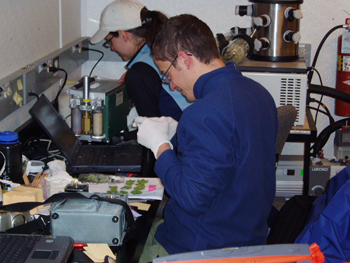
Studies over the last two decades in the Arctic have determined that nutrients limit plant growth and determine species variability there. At the Imnavait Creek watershed, downhill channels of flowing water, or “water tracks” have been found to deliver more nutrients to the flow-channel and to downslope areas than two areas adjacent to the flow channel or upslope. In these water tracks, deciduous species, most noticeably the dwarf birch Betula nana, dominate the vegetation. Deciduous species are present elsewhere but are not as dominant. The aim of this study was to determine whether the advantage that allows deciduous species to dominate water tracks is a realized increase in photosynthetic capability resulting from increased nutrient supply. Increased nutrient input has previously been shown to increase photosynthesis in many other C3 plants. A novel method (rapid light curves, RLC) employing chlorophyll florescence parameters was used to determine the maximum electron transport rate in the photosynthetic chain, and thus the photosynthetic status, of seven species of plants representing all four functional groups in the watershed, both in and out of water tracks. It was determined that photosynthetic rate generally decreased downslope, and was not significantly different between water tracks and adjacent areas, Hence it was determined that photosynthetic rate was not increasing in parallel with increased nutrient input, and that deciduous species must employ some other method to dominate areas of high nutrient input. Based on measurements of canopy cover and physical parameters such as shoot diameter and height, a hypothesis is offered: Betula nana dominates in areas of high nutrient input by allocating preferentially to the establishment of high and sprawling canopy, a strategy that imposes light-limitations on shorter species when many Betula appear in one area. Additionally, the deciduous plan Rubus chamaemorus, while not tall, capitalizes on Betula’s dominance, as Rubus was found to reach peak photosynthetic electron transport rate even at very low light levels, rendering it less susceptible to the shading of Betula. Human disturbances, both on local levels and on the scale of the entire Arctic are predicted to increase nutrient influx there. An understanding of species change in such a scenario is important, especially because many areas of the Low Arctic, including Imnavait Creek, are known to teeter on the edge of being a carbon source versus a sink with respect to the atmosphere. It is already known that leaf-area per ground-area in the Imnuviat Creek watershed determines the sink/source status of the region, and it is possible that dominance of deciduous species, while perhaps increasing canopy cover, decreases total leaf area per ground area.
 |
|
David at work in the lab at Toolik Alaska. |
|
Go to Science Research Projects.
Go to Learning Objectives of Research Project.
Return to E&ESJ home page.
Last updated: 19 January 2006, MKT.